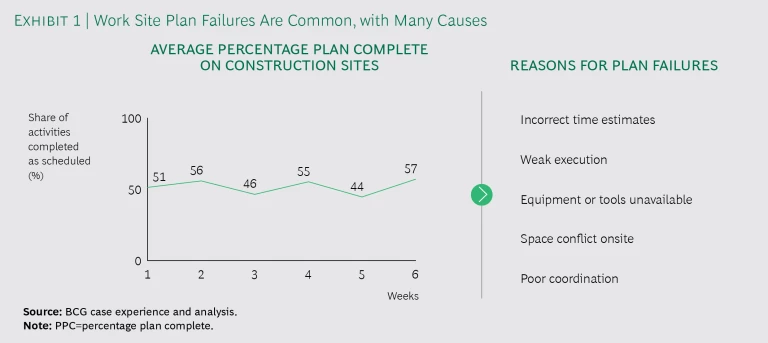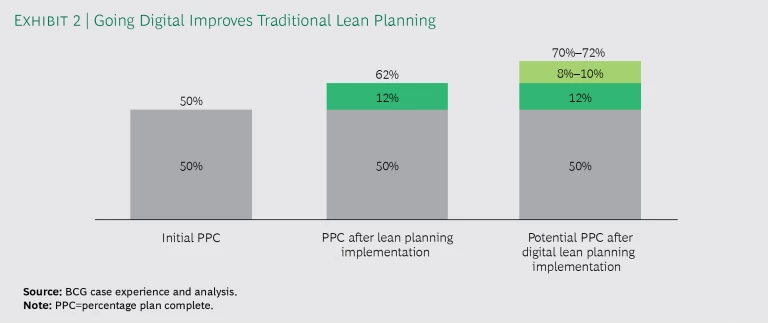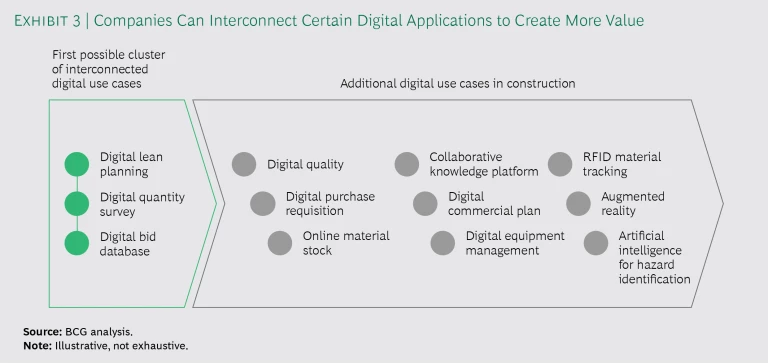As an industry, construction is one of the least digitized. It also faces a chronic problem of low productivity, the product of faulty planning and poor collaboration that cause delays and increase costs. Only about 50% of planned activities on a construction site are completed on schedule—no better than a coin toss. But by applying digital lean methods at the construction site, we estimate companies can improve their plan completion rate to more than 70%.
Only about 50% of planned activities on a construction site are completed on schedule—no better than a coin toss.
Most construction companies, if they attempt to digitize at all, focus on digitizing high-level IT processes at the top of the organization—the building information modeling (BIM) level. This digital transformation is a worthy mid- to long-term goal, but companies should also consider applying digital lean at the bottom of the organization—the construction site itself—to narrow objectives to achieve tangible results more quickly.
Once a company has perfected its digital lean techniques, it can expand to other related activities and accrue ever greater benefits. Given the low level of digitization in the industry, those companies that embrace digital lean could reap dramatic productivity gains and give themselves a competitive advantage. (See “ How Technology Is Revolutionizing Construction ,” BCG article, June 2016.)
Start with Traditional Lean Principles
Despite the digital revolution that has swept over global business, construction is stuck at the same productivity levels as it was in the mid-1990s. Workers at construction sites still spend about 30% of their time simply waiting to do their jobs, for any number of reasons—materials haven’t been delivered, equipment is broken, or a precursor step is delayed. To get a handle on the scale of this problem, we use a measure known as “percentage plan complete” (PPC).
Despite the digital revolution that has swept over global business, construction is stuck at the same productivity levels as it was in the mid-1990s.
A good proxy for both productivity and cost, PPC is stuck at around 50% in the construction industry. (See Exhibit 1.)
The first step to tackling low productivity and increasing PPC is to apply traditional lean techniques to planning and collaboration capabilities.
Lean planning focuses on specific tools and routines to ensure the activities planned at the work site are feasible. It also aims to improve communication and problem solving between the work site and centralized functions at headquarters, including the technical or design office, procurement, health and safety, the quality department, and cost control. The goal is to increase plan stability at the work site to keep plans on time and on budget.
Lean planning has three pillars:
- Weekly site meetings between the site manager, area planner, and foreman or supervisor—to plan site activities, and prepare for next week’s activities.
- Joint operation meetings between the construction manager, area planner, and site managers—for performance review and progress updates, to analyze plan failures, and develop weekly operational targets.
- Problem-solving routines between the site manager, area planner, and technical office manager—to review and prioritize the action list and conduct status updates.
Using lean to systematically analyze the root cause of plan failures can yield valuable insights. For example, just identifying conflict over space as the reason for a plan failure is too simplistic. Lean goes a step deeper to identify the root cause of that space conflict, such as a crane capacity bottleneck, in order to design solutions more precisely to improve productivity. By involving subcontractors in planning, harmonizing the daily workload and head count, and improving equipment work cycles, lean can reduce budget costs and improve PPC from 50% to about 62%.
Lean can reduce budget costs and improve PPC from 50% to about 62%.
Evolve from Traditional to Digital Lean
While traditional lean can bring sizable improvements to the construction work site, it has intrinsic limits. Even after applying traditional lean techniques to planning, supervisors often don’t have all the information they need for design and procurement decisions and must make choices based on their best guess about a third of the time. Not surprisingly, 23% of plans fail due to inaccurate planning.
Even after applying traditional lean techniques to planning, supervisors often don't have all the information they need. Not surprisingly, 23% of plans fail due to inaccurate planning.
Our research involving many in-depth, face-to-face interviews with practitioners in the field identified several areas where construction companies would like to see improvements beyond what traditional lean planning offers. These include improving the efficiency of meetings, identifying additional metrics to gauge productivity, reducing time spent on report generation, and tracking people’s participation in planning and problem solving more precisely and easily.
To seize these opportunities and take productivity to the next level, construction companies should apply digital to lean planning so foreman, subcontractors, and support staff in the field can more easily communicate, receive task assignments, check documents, and report progress through digital devices such as their mobile phones and laptops. In addition to the incremental improvements to traditional lean listed above, digital lean offers new functionalities and some disruptive improvements. These include: keeping physically distant team members always connected, with access to real-time, up-to-date plans; analyzing huge amounts of information to improve business decisions; and tailoring information sharing to people’s roles and responsibilities.
Several digital applications already exist that include some lean planning functionalities, such as providing detailed Gantt charts, and supporting design and document collaboration. (See “Shaping the Future of Construction: Inspiring Innovators to Redefine the Industry,” BCG article, March 2017.) This functionality is a good start, but it is not enough to fully support the lean planning process. Ultimately, digital can boost lean benefits and increase PPC. (See Exhibit 2.)
To do so, however, the apps need to include four key design principles:
- Tailored Interfaces. All the key personnel—including planners, engineers, and those in operations—need interfaces tailored to their specific roles. For example, planners at headquarters need a detailed interface accessible from a desktop computer that allows them to perform advanced tasks, such as managing activity dependencies, computing delays, and applying various filters to generate specific views. Meanwhile, operators and team leaders in the field using mobile phones need a more simplified interface with limited functionalities so, for example, they can receive task assignments and report on material quantities for procurement.
- Visually Effective. Applications are often far too technical in nature. A good digital lean planning tool should have a simple interface that delivers easy-to-read reports and clear graphs to engage people at all levels of the organization, whatever their technical abilities.
- Enhanced Meetings. Digital lean applications can make it easier to plan meetings, conduct meetings remotely, and even mimic certain critical meeting dynamics, such as a commitment button or similar function that team members can click on to commit to a plan. Digital lean can also help make meetings more efficient by, for example, delivering all materials electronically before the meeting starts (as opposed to printing copies while people are sitting in a conference room).
- Modular and Expandable. Any lean planning application should be modular, allowing people to implement lean planning step by step over time. For example, in the first month, lean might be applied only to the site routine, and then in the second month to the joint operation meeting. These individual modules need to work together even when they are switched on at different times. Any lean planning application should also be expandable, with the ability to interface with other digital apps and share data in different formats.
Look to Digitize Other Activities
Once a company has digital lean planning up and running, it should look to digitize other activities in the construction value chain. Specifically, the company should look to digitize activities that can complement and strengthen planning by capitalizing on a shared data set.
Specifically, the company should look to digitize activities that can complement and strengthen planning by capitalizing on a shared data set.
With this in mind, our research identified two ideal tools to complement digital lean planning:
- Digital Quantity Surveys. These gather data about the quantity of material and work accomplished on-site, such as the amount of cable or steel installed.
- Digital Bid Database. These collect historical data about project budgets and actual productivity rates.
These three activities—digital lean planning, digital quantity surveys, and digital bid databases—complement one other so well because together they assemble and share a large and accurate data set to monitor and steer site activities. (See Exhibit 3.) Together they enable quick responses when plans unexpectedly change, allow site managers to make more informed decisions, and help companies make more precise project bids based on actual data about past project budgets and performance.
The construction industry should gather, connect, and exploit data from the field in ways
The Lean Advantage for Large Construction Projects
for decades. (See “The Lean Advantage for Large Construction Projects: Industrializing Project Execution to Create Value,” BCG Focus, December 2015.) Applying digital lean planning at construction work sites can quickly produce tangible results. While companies should continue to digitize high-level IT processes at the BIM level, they should pay more attention to work sites as places to solve significant pain points and drive productivity gains after decades of stagnation.















